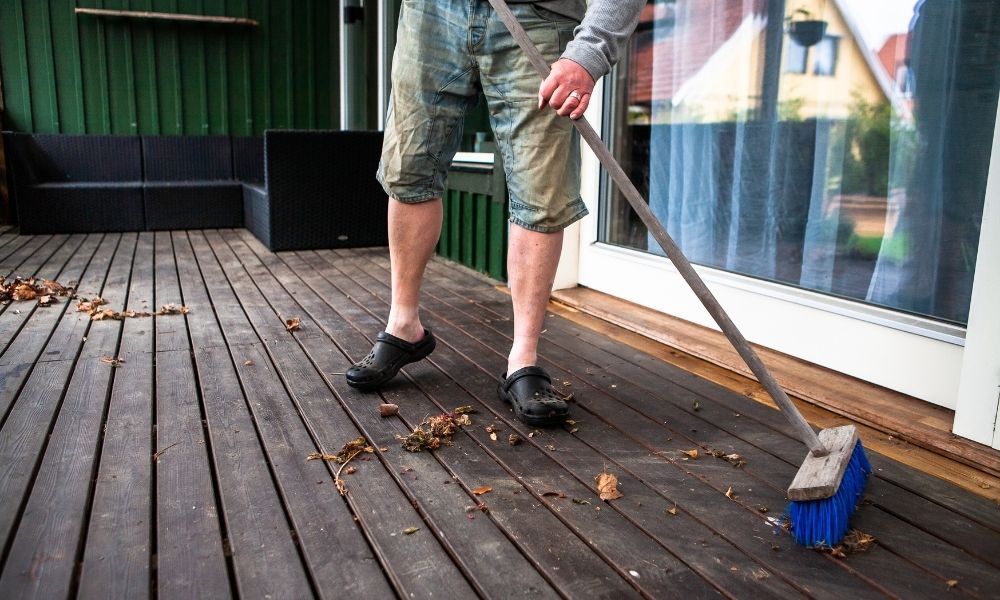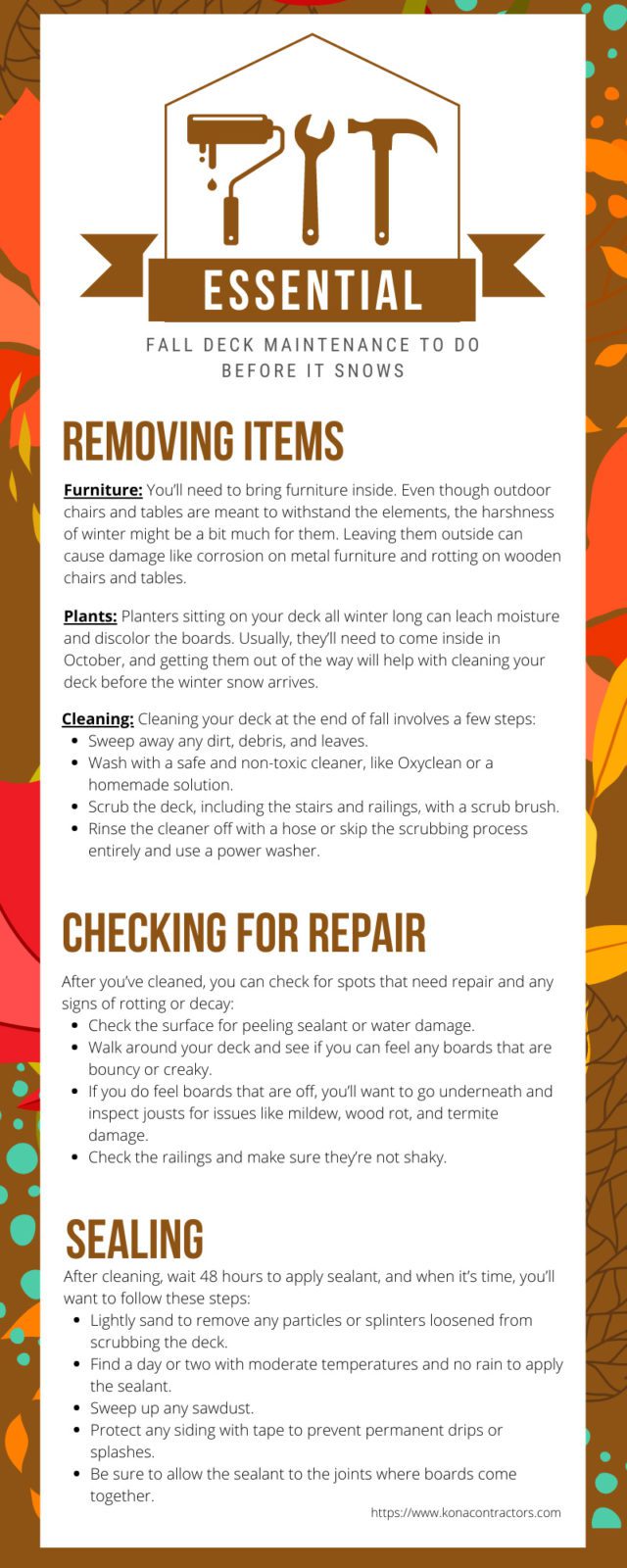
Essential Fall Deck Maintenance To Do Before It Snows
Labor Day marks the end of summer, and unfortunately, the beginning of the end for deck season. Preparing your deck for the sleet and snow of winter involves more than bringing your chairs inside. There is some essential fall deck maintenance to do before it snows, like cleaning, repairing, and protecting your deck for the months ahead.
Find out more about how to protect your deck from the harsh elements of winter so you can enjoy it once spring returns.
Removing Items
As fall ends and winter approaches, you’ll need to begin the process of winterizing your deck before the first snowfall, and it begins with removing items from your deck:
Furniture
You’ll need to bring furniture inside. Even though outdoor chairs and tables are meant to withstand the elements, the harshness of winter might be a bit much for them. Leaving them outside can cause damage like corrosion on metal furniture and rotting on wooden chairs and tables.
Plus, deck furniture sitting in the same spot as ice and snow accumulates around it can cause problems for the structure of your deck and leave rusty stains.
Ideally, you should store them in a safe place like your garage or basement, but if you have nowhere else to put them, stack them and cover them with a tarp to protect the furniture and your deck.
Plants
Of course, plants will need to come inside for the cold months ahead, but it’s also for the benefit of your deck. Planters sitting on your deck all winter long can leach moisture and discolor the boards. Usually, they’ll need to come inside in October, and getting them out of the way will help with cleaning your deck before the winter snow arrives.
Cleaning
After you’ve removed the furniture and plants, it’s time to clean the deck. Leaving debris to sit on the surface will cause rotting and, again, can cause problems.
Before cleaning, you’ll want to cover any plants or bushes underneath or next to the deck with a drop cloth to protect them. Choosing an overcast day for cleaning the deck is best since direct sunlight can dry out cleaner too quickly. Some manufacturer’s instructions require you to wait a certain amount of time before rinsing it off.
Cleaning your deck at the end of fall involves a few steps:
- Sweep away any dirt, debris, and leaves.
- Wash with a safe and non-toxic cleaner, like Oxyclean or a homemade solution.
- Scrub the deck, including the stairs and railings, with a scrub brush.
- Rinse the cleaner off with a hose or skip the scrubbing process entirely and use a power washer.
Cleaning also helps to remove any mildew or mold that would have thrived underneath a dark tarp during the winter. Before moving forward with winterizing, you’ll want to check for spots that need repair.
Checking for Repair
After you’ve cleaned, you can check for spots that need repair and any signs of rotting or decay. Checking for maintenance work now will help your deck avoid any serious damage, since severe weather can make any cracks, mildew, or water damage worse:
- Check the surface for peeling sealant or water damage.
- Walk around your deck and see if you can feel any boards that are bouncy or creaky.
- If you do feel boards that are off, you’ll want to go underneath and inspect jousts for issues like mildew, wood rot, and termite damage.
- Check the railings and make sure they’re not shaky.
Composite decks won’t mildew, but there still might be issues like a loose screw or railing you should tighten, so ice and snow that seeps in doesn’t cause any damage.
Sealing
Homeowners with wooden decks should add sealant before the first snowfall. Since composite decking is already waterproof, you won’t need to take this step.
After cleaning, wait 48 hours to apply sealant, and when it’s time, you’ll want to follow these steps:
- Lightly sand to remove any particles or splinters loosened from scrubbing the deck.
- Find a day or two with moderate temperatures and no rain to apply the sealant.
- Sweep up any sawdust.
- Protect any siding with tape to prevent permanent drips or splashes.
- Be sure to allow the sealant to the joints where boards come together.
Once the sealant is fully dried, you can cover the deck with a tarp (as much of it as you can) to create a barrier between the boards and moisture.
Wintertime Do’s and Don’ts
Removing plants and furniture, cleaning, and sealing your deck is what you’ll need to do to protect your deck from the deluge of ice and snow that will pile up on it during the winter.
But there are also some winter do’s and don’ts you’ll want to keep in mind:
Do Keep an Exit Clear
Even though you won’t be using your deck during winter, you’ll still want to keep an exit clear from your back door to the yard, especially if you have children and pets. In case of an emergency, you’ll want to keep a walkway clear.
And if you can, try to clear a pathway that’s next to the railing to give your family stability when walking outside to your yard.
Don’t Use a Metal Shovel
When you’re shoveling snow, be sure to use a plastic snow shovel and not a metal one. Why? Metal shovels can damage your deck easily! You’ll run the risk of gouging or scratching the floorboards or scrapping off the sealant you have just reapplied.
Even if a tarp covers your floorboards, a metal snow shovel can still do damage.
Do Remove Moisture from the Deck
Moisture is obviously the biggest concern when winterizing. Of course, no one expects their deck to be free of ice and snow all winter long, but it’s when the snow and ice melt that can cause problems.
Melting ice and snow will cause pools of water to form, and it’s a good idea to remove them when you see them. Otherwise, moisture can seep into the wood and leave you with warped and discolored floorboards come springtime.
Don’t Use Salt To De-Ice
Salt is a tool to combat icy sidewalks and driveways during the winter, but it shouldn’t be used on decks. Salt will pit and dry out wood and weaken the structure. You’ll want to find a salt-free option to make walking on your deck safe; some common household items work really well for this, like sand, coffee grounds, and kitty litter.
Composite Decking
Did you know that composite decking won’t decay, splinter, or have insect damage? The essential fall deck maintenance to do before it snows will help any deck survive winter weather, but composite decking is more durable and will prevent any need for deck repair in Denver.
Learn more about design and caring for your deck with the resources at Kona Contractors!

